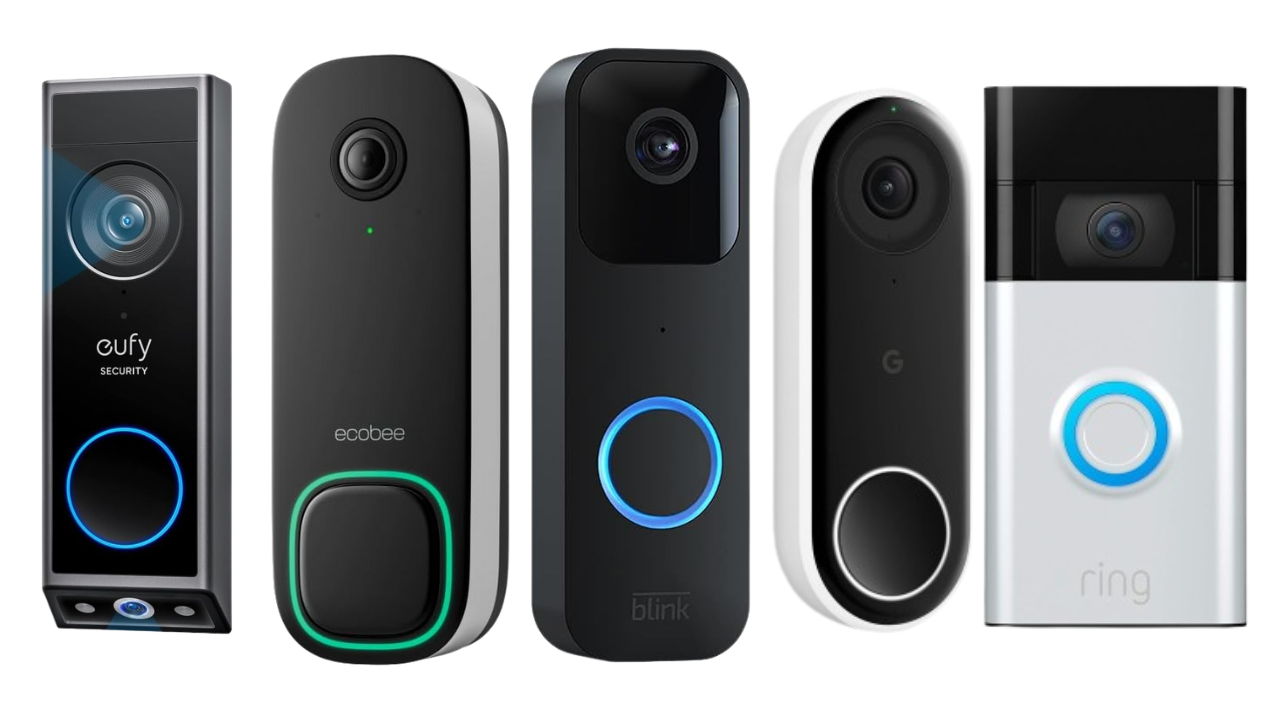The wireless doorbell is a modern and convenient alternative to traditional wired doorbells, offering a seamless and hassle-free way to enhance home security and convenience. Unlike wired counterparts, wireless doorbells operate without the need for complex installations, making them user-friendly for both homeowners and renters.
These devices typically consist of a transmitter (button) installed near the entrance and a receiver inside the house. When the doorbell button is pressed, it wirelessly signals the receiver to emit a chime or sound, alerting occupants of visitors.
Wireless doorbells often boast a range that allows flexibility in placement, enabling users to position the receiver where it’s most audible. Additionally, many models offer customizable chimes, volume settings, and even visual indicators for the hearing impaired. Some advanced versions may integrate with smartphone apps, allowing remote monitoring and interaction.
This technology enhances home security by providing an audible alert for unexpected visitors or deliveries, contributing to peace of mind. Its easy installation, portability, and diverse features make the wireless doorbell a popular choice for those seeking a modern, user-friendly solution to doorbell functionality.
Table of Contents
Doorbell
The doorbell is a ubiquitous and essential fixture in homes worldwide, serving as a fundamental means of announcing a visitor’s presence. Traditional doorbells are wired devices comprising a button near the entrance and a chime or bell inside the house. When the button is pressed, an electrical circuit is completed, triggering the chime to produce a sound, alerting occupants.
Over time, doorbell technology has evolved, with wireless variants emerging as popular alternatives. Wireless doorbells eliminate the need for complex wiring, making installation more accessible. They typically consist of a button that wirelessly communicates with a receiver inside the home, producing a chime or alert when activated.
Modern doorbells often feature customizable sounds, adjustable volume levels, and even integration with smart home systems. Some advanced models may include cameras or intercom systems, providing additional security and convenience. The doorbell remains a simple yet effective tool for enhancing home security, convenience, and communication, serving as a first point of contact between visitors and residents.
Our Picks: Best Doorbell
1
Ring Video Doorbell
The Ring Video Doorbell in Satin Nickel is a cutting-edge home security device designed to provide users with advanced features for monitoring and securing their homes. Boasting a high-definition 1080p video camera, this ring doorbell allows homeowners to enjoy crystal-clear video quality, enabling them to see and interact with visitors in real-time through a connected mobile app.
One standout feature is the improved motion detection system, which enhances the device’s ability to detect and alert users to activity near their front door. This capability adds an extra layer of security, providing timely notifications about potential visitors or suspicious movements.
Ease of installation is a key selling point of the wireless doorbell. With a wireless design, it eliminates the need for complex wiring, making it a user-friendly option for homeowners and renters alike. The sleek Satin Nickel finish not only adds a touch of modern style to the exterior of the home but also complements various architectural aesthetics.
The Ring Doorbell in Satin Nickel combines high-quality video, enhanced motion detection, and easy installation, offering a comprehensive solution for home security and peace of mind.
2
Blink Video Doorbell
The Blink Doorbell is a versatile and feature-rich home security solution designed to provide users with enhanced monitoring and communication capabilities. Boasting two-way audio, this doorbell allows homeowners to engage in real-time conversations with visitors at their doorstep, adding an interactive element to home security.
Equipped with HD video capabilities, the Blink Doorbell ensures clear and crisp footage of the surroundings, offering a detailed view of anyone approaching the entrance. The device’s motion detection system triggers timely app alerts, keeping users informed about activity near their front door, whether it’s a delivery or unexpected visitor.
The integration with the Blink app further enhances the user experience by providing chime alerts directly to the user’s mobile device. This feature ensures that homeowners are instantly notified, even when they are away from home.
Moreover, the Blink Video Doorbell is Alexa-enabled, allowing users to integrate it seamlessly with their Amazon Alexa devices for voice control and a more connected smart home experience. The flexibility of both wired and wire-free installation options caters to various user preferences and home setups.
The Blink Video Doorbell offers a comprehensive package with two-way audio, HD video, motion alerts, chime app integration, and Alexa compatibility, making it a reliable and user-friendly choice for modern home security.
3
Google Nest Doorbell
The Google Nest Doorbell (Wired), formerly known as Hello Video Doorbell, stands out as a sophisticated and reliable smart home security device. With the capability for 24/7 streaming, this wired doorbell ensures constant surveillance of the front door area, providing users with real-time visibility into their home surroundings.
Featuring HDR video technology, the Nest Doorbell delivers high-quality visuals, capturing details even in challenging lighting conditions. The inclusion of HD Talk and Listen functionality enables clear and two-way communication between homeowners and visitors, enhancing the interactive aspect of home security.
Equipped with night vision capabilities, the Nest Wireless Doorbell ensures that users have a clear view of their doorstep even in low-light or nighttime conditions. This feature contributes to the device’s comprehensive surveillance capabilities, providing round-the-clock security.
The implementation of person alerts is a noteworthy feature, distinguishing between human activity and other motion events. This helps minimize unnecessary notifications and ensures that users are promptly alerted to potentially significant events at their doorstep.
The Google Nest Doorbell (Wired) combines advanced features such as HDR video, HD Talk and Listen, night vision, and person alerts to offer a comprehensive and intelligent wireless doorbell solution, contributing to enhanced home security and peace of mind.
4
Ecobee Smart Video Doorbell
The Ecobee Smart Video Doorbell Camera (Wired) is a feature-rich and technologically advanced device designed to elevate home security and convenience. Boasting an industry-leading HD camera, this smart doorbell ensures clear and detailed video footage, providing homeowners with a comprehensive view of their doorstep and surroundings.
One standout feature is the inclusion of smart security elements, including person and package sensors. These sensors enable the doorbell to differentiate between human activity and package deliveries, providing more accurate and targeted alerts to users. This helps users stay informed about relevant events and reduces unnecessary notifications.
Equipped with night vision capabilities, the Ecobee Smart Video Doorbell ensures visibility in low-light conditions, maintaining effective surveillance around the clock. The 2-way talk feature allows for real-time communication between homeowners and visitors, adding an interactive dimension to the wireless doorbell’s functionality.
Video and snapshot recording capabilities further enhance the device’s utility, allowing users to review and save important footage. This feature is particularly valuable for monitoring and documenting security events.
The Ecobee Smart Video Doorbell Camera (Wired) integrates an industry-leading HD camera, smart security sensors, night vision, 2-way talk, and video & snapshot recording, providing users with a comprehensive and intelligent solution for home security and communication.
5
Eufy Security Video Doorbell
The Eufy Security Video Doorbell E340 (Battery Powered) is a cutting-edge home security device that offers a range of features for enhanced monitoring and peace of mind. Powered by a battery for hassle-free installation, this wireless doorbell boasts dual cameras, featuring Delivery Guard technology to ensure users never miss important deliveries.
With a 2K Full HD resolution, the Eufy Security Video Doorbell provides sharp and clear video footage, offering detailed views of the doorstep and surroundings. The inclusion of color night vision is a standout feature, enabling homeowners to see and identify visitors even in low-light conditions, contributing to comprehensive surveillance.
Compatibility with the HomeBase S380 adds an extra layer of convenience, allowing users to integrate the doorbell seamlessly into their existing Eufy security system. Notably, the absence of a monthly fee makes this doorbell a cost-effective option for users looking to avoid ongoing subscription costs while still benefiting from advanced security features.
The Delivery Guard feature enhances the device’s functionality by providing specific alerts for package deliveries, ensuring users are promptly notified when packages arrive at their doorstep.
The Eufy Security Video Doorbell E340 (Battery Powered) combines dual cameras with Delivery Guard, 2K Full HD resolution, color night vision, HomeBase S380 compatibility, and a no-monthly-fee model, making it an attractive and comprehensive solution for modern home security needs.
Benefits of Wireless Doorbell
Wireless doorbells offer several benefits that contribute to their popularity and widespread adoption in modern homes:
Easy Installation:
Wireless doorbells eliminate the need for complex wiring, making them user-friendly and suitable for both homeowners and renters. This ease of installation also allows for flexible placement options.
Portability:
Wireless doorbells are portable and can be easily moved or relocated within the home. This flexibility is particularly advantageous for those who may want to change the doorbell’s placement or take it with them when moving to a new residence.
Minimal Installation Costs:
Since there is no need for professional installation or complex wiring, the associated costs are typically lower compared to wired doorbell systems. This makes wireless doorbells a cost-effective option for those on a budget.
Range of Operation:
Wireless doorbells often come with a generous range of operation, allowing the receiver to be placed at a distance from the transmitter. This is especially useful in larger homes or buildings where the doorbell may be located far from the central living areas.
Customizable Features:
Many wireless doorbell models offer customizable features such as a variety of chimes, volume settings, and even visual indicators. Some advanced models integrate with smartphone apps, providing additional customization options and remote monitoring capabilities.
Enhanced Security:
Wireless doorbells contribute to home security by providing instant alerts when someone is at the door. Some models even come with built-in cameras, enabling homeowners to see and communicate with visitors remotely, adding an extra layer of security.
Integration with Smart Home Systems:
Many wireless doorbells are compatible with smart home systems, allowing integration with other devices and applications. This can include syncing with virtual assistants like Amazon Alexa or Google Assistant for voice control and broader home automation.
Battery-Powered Options:
Battery-powered wireless doorbells eliminate the dependence on electrical wiring, ensuring continued functionality during power outages. They also offer a convenient and energy-efficient option for homeowners.
The wireless doorbells provide easy installation, portability, cost-effectiveness, customization, security enhancements, and compatibility with smart home systems, making them a convenient and modern choice for homeowners seeking an efficient and flexible doorbell solution.
Factors to be Consider for Wireless Doorbell
When selecting a wireless doorbell, several factors should be considered to ensure that the chosen device meets your specific needs and preferences. Here are key factors to keep in mind:
Range:
Consider the range the wireless doorbell offers. Ensure that the signal can cover the distance between the doorbell button and the receiver, especially in larger homes or buildings.
Installation Ease:
Look for a wireless doorbell that is easy to install. Most wireless doorbells are designed for simple DIY installation, but some may have specific requirements or complexities to consider.
Power Source:
Wireless doorbells can be battery-powered or may require an electrical connection. Determine which power source aligns with your preferences and the convenience of your home’s setup.
Customization Options:
Check for customization features such as various chime options, adjustable volume settings, and visual indicators. The ability to personalize the doorbell’s settings can enhance the user experience.
Compatibility:
If you have other smart home devices, check whether the wireless doorbell is compatible with your existing systems. Integration with virtual assistants like Amazon Alexa or Google Assistant may be desirable for a cohesive smart home setup.
Security Features:
Some wireless doorbells come with built-in cameras for added security. Consider whether you want video capabilities, night vision, and two-way communication to see and communicate with visitors.
Weather Resistance:
Ensure that the wireless doorbell is designed to withstand the elements, especially if it will be exposed to rain, snow, or extreme temperatures. Look for a doorbell with a high IP (Ingress Protection) rating for weather resistance.
App Integration:
If you prefer remote monitoring and control, choose a wireless doorbell that integrates with a smartphone app. This allows you to receive alerts, view video feeds, and interact with the doorbell remotely.
Frequency Interference:
Check the frequency of the wireless doorbell and ensure it does not interfere with other devices in your home. Some models offer the ability to change frequencies to minimize interference.
Battery Life:
For battery-powered doorbells, consider the expected battery life. Long-lasting batteries or rechargeable options can reduce the frequency of replacements and maintenance.
Warranty and Support:
Look for a wireless doorbell with a reliable warranty and good customer support. This ensures that you have recourse in case of malfunctions or issues with the device.
By carefully considering these factors, you can choose a wireless doorbell that aligns with your preferences, enhances your home security, and integrates seamlessly into your living space.
Maintenance and Care of a Doorbell
Maintaining and caring for a doorbell is essential to ensure its longevity, reliability, and continued functionality. Here are some tips for the maintenance and care of a doorbell:
Regular Cleaning:
Keep the doorbell and its components clean from dust, dirt, and debris. Wipe down the button, chime unit, and any visible wiring regularly to prevent the buildup of grime that could affect performance.
Inspect Wiring:
Periodically inspect the wiring to ensure it is in good condition. If any issues are found, address them promptly to avoid electrical problems.
Battery Replacement:
If your doorbell is battery-powered, replace the batteries as needed. Regularly check the battery levels and replace them before they run out to ensure uninterrupted operation.
Tighten Loose Screws:
Over time, screws on the doorbell button or chime unit may become loose. Periodically check and tighten any loose screws to maintain a secure installation.
Weatherproofing:
If your doorbell is exposed to the elements, ensure that it is adequately weatherproofed. This may involve applying a sealant around the doorbell button or using a weatherproof cover to protect it from rain, snow, or extreme temperatures.
Test the System:
Regularly test the doorbell system to ensure it is working correctly. Press the button to check if the chime unit produces the expected sound. If you have a video doorbell, verify that the camera and intercom functions are functioning properly.
Check for Interference:
If you notice issues with signal reception or interference, consider changing the frequency settings on your wireless doorbell. This can help optimize its performance in environments with multiple electronic devices.
Secure Mounting:
Ensure that the doorbell button is securely mounted. If it becomes loose or misaligned, it may not function properly. Adjust the mounting as needed to maintain a secure and functional installation.
Update Firmware/Software:
If you have a smart doorbell with firmware or software updates, make sure to keep it up to date. Regular updates may include improvements to performance, security, and additional features.
Follow Manufacturer’s Instructions:
Always refer to the manufacturer’s instructions and guidelines for your specific doorbell model. These instructions often provide valuable information on installation, maintenance, and troubleshooting.
Professional Inspection:
If you encounter persistent issues or are unsure about the condition of your doorbell, consider consulting a professional for inspection and maintenance. They can identify and address any underlying problems.
By incorporating these maintenance practices into your routine, you can ensure that your doorbell remains in optimal condition, providing reliable service for years to come.
Conclusion
A doorbell is a simple yet indispensable component of modern homes, serving as the first point of contact between visitors and residents. As technology has advanced, doorbells have evolved beyond their basic functions, offering a variety of features to enhance security, convenience, and communication.
Whether traditional wired models or modern wireless variants, simplisafe doorbells play a crucial role in alerting occupants to the presence of guests, deliveries, or potential security concerns. The choice between wired and wireless doorbells depends on individual preferences, installation requirements, and desired features.
Innovations such as video capabilities, two-way communication, and smart home integration have transformed doorbells into sophisticated devices that contribute to the overall safety and efficiency of households. Homeowners now have the option to remotely monitor their entrances, communicate with visitors, and even receive alerts for package deliveries, adding layers of convenience and security to daily life.
Regular maintenance, such as cleaning, inspecting wiring, and addressing issues promptly, is key to ensuring the simplisafe doorbell’s reliable performance over time. Additionally, advancements in battery life, weatherproofing, and customization options contribute to the durability and adaptability of modern doorbells.
Ultimately, the humble doorbell, in its various forms, remains a fundamental element of home security and communication, bridging the gap between the exterior and interior of a residence. As technology continues to evolve, the doorbell will likely continue to evolve with it, offering homeowners ever-improving ways to stay connected and secure in their living spaces.
FAQs
Q: How do I install a wireless doorbell?
A: Installing a wireless doorbell is typically a straightforward process. Most models come with step-by-step instructions. In general, you’ll need to mount the button near your entrance and place the receiver inside your home. Wireless doorbells often use batteries, eliminating the need for wiring.
Q: Can I replace my existing wired doorbell with a wireless one?
A: Yes, you can usually replace a wired doorbell with a wireless model. Keep in mind that wireless doorbells may have different installation requirements, and you might need to remove or bypass existing wiring.
Q: Are wireless doorbells secure?
A: Wireless doorbells are generally secure, using encryption and secure communication protocols. However, it’s essential to follow best practices for securing your home Wi-Fi network to prevent unauthorized access.
Q: Can I integrate my doorbell with a smart home system?
A: Many modern wireless doorbells are compatible with smart home systems. They can integrate with virtual assistants like Amazon Alexa or Google Assistant, allowing for voice control and additional automation features.
Q: How do I maintain my doorbell?
A: Regular maintenance involves cleaning the doorbell button and receiver, checking for loose screws, inspecting wiring (if applicable), and ensuring the power source (battery or wiring) is in good condition. Follow the manufacturer’s guidelines for specific maintenance recommendations.
Q: Can I install a wireless doorbell camera by myself?
A: Yes, many wireless doorbell cameras are designed for DIY installation. They typically come with detailed instructions, and installation tools are often included. However, if you’re uncomfortable with the installation process, consider seeking professional assistance.
Q: Do wireless doorbells work during a power outage?
A: Battery-powered wireless doorbells will continue to work during a power outage. However, if your home Wi-Fi network relies on mains power, smart features (such as video streaming) may be temporarily unavailable.
Q: Are there wireless doorbells with night vision capabilities?
A: Yes, many doorbell cameras come equipped with night vision capabilities, allowing for clear visibility in low-light or nighttime conditions. This enhances the doorbell’s security features.
Q: Can I customize the sound of my wireless doorbell chime?
A: Many wireless doorbells offer customizable chime options. You can often choose from a variety of sounds and adjust the volume to your preference. Check the features of your specific model for customization options.








